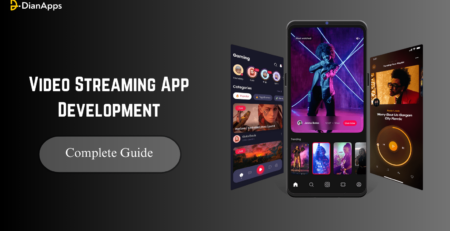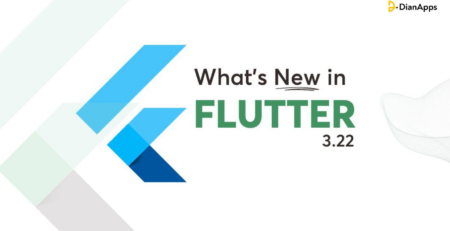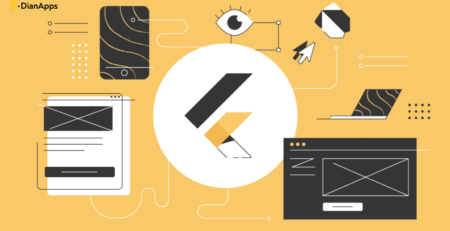Flutter For Enterprise App Development: A CEO’s Guide
Flutter needs no introduction, the framework is vigorously becoming every developer and organization’s go-to mobile app development technology. Speaking of popularity, Flutter solutions have been helping businesses of all-size reach a massive count of user-base and that too in a cost-efficient space.
Enterprises looking to develop their project application are all set to pave the golden period of ruling the mobile development realm. According to recent statistics, the constant upliftment of Flutter app development services as a cross-platform framework among the community. With the popularity figure rising from 30% in 2019, 39% in 2020, and 42% in 2021, it is pretty clear to predict that by the end of 2022, this popularity scale will reach 50% among app developers.

The above-mentioned stats indicate the cut-to-cut competition amidst react native and flutter app development for cross-platform needs. Soon, flutter is going to access the entire mobile app development framework’s demand and is definitely the best option for enterprise app development.
In this blog, we will be discussing some fact that highlights why futter is being used for enterprise app development company. Let’s get started!
Why is Flutter so popular among developers?
One of the primary reasons why Flutter is so popular is its Google-backed open-source hybrid app development framework that seamlessly supports C, C++, and Dart programming languages. In addition to this, building enterprise apps with native-like appease is a bonus point for flutter’s visibility in the market.
Even though the framework uses three essential programming languages, the demand for Dart is extensively been used by most developers. Wondering why flutter choose to go with Dart over the other two programming languages? Or why do developers prefer Dart in flutter app development services? Find out the reason below.
Dart is a web-based, object-oriented programming language. Kotlin is now being replaced by Dart in the creation of mobile apps. The cause? It does away with the requirement for declarative layout languages like XML and JSX. With its Just-In-Time Compiler and Ahead of-time capability, Dart’s quick compilation speeds up Flutter’s performance by enabling advanced customizable widgets and object-oriented features.
According to a poll conducted by Google in 2020, there are around 2 million flutter developers, of whom 5,000 employ the Flutter Software Development Kit exclusively.
Flutter is a cross-platform app development framework that offers developers several advantages, including:
- One Codebase: Create code that feels natively integrated across all platforms (mobile, online, and desktop).
- A real tree data structure created by integrating multiple stateless widgets in a simple organizing way is known as a widget tree structure.
- Hot Reloading: Aids programmers in quickly identifying and fixing bugs in application code.
- Utilizes pre-built libraries and widget UI kits to simplify the development of pixel rendering and provide more control over the pixels on the screen. a 2D rendering engine, etc.
Developers choose Flutter over many other cross-platform app development frameworks for a number of additional reasons.
Read about why: choose Flutter for your next app development project.
Why use Flutter for Enterprise App Development?
Enterprise apps are designed with a wide user base in mind while taking into account specialized applications and robust cybersecurity. They are suitable for all sorts of organizations, including revolutionary startups, medium-sized companies, and large-scale corporations.
With enterprise applications, administrators have complete control over centralizing data management, starting process automation throughout the whole firm, and, if necessary, implementing an event-driven methodology.
Flutter is the ideal choice for building corporate apps on a large scale since it includes more than 4000 libraries and strong support from the open-source community.
Let’s examine the corporate mobile app development needs that Flutter satisfies and makes profitable as we place more attention on Flutter enterprise software development company.
1. Layered Architecture for Proven Efficiency
For better implementation of the display layer, service layer, business logic layer, and data access layer, enterprise software adheres to a layered architecture of linked layers.
The following specifications must be met by mobile app developers when using this layered architecture:
- Availability of well-documented requirements for app development
- Cognitive team communication and collaboration across the entire organization
- Validated codebase documentation is written in plain English
- Improved navigation and clear app features
By offering secure networking to web resources, storage systems (local + SQL database), and library plugins for greater hardware accessibility, Flutter app development supports developers in the following ways:
- Flutter’s core functionality is easy to state management, which is accomplished through collaboration with open-source technologies like Provider Framework and modules like BLoC, Redux, setState, etc. Additionally, RxDart is the best option for integrating State Management and Flutter tools and for asynchronous programming needs.
- Code Independence: Dependency injection is required to make your code independent for processing on many native platforms. GetIT Locator, a DI library that closely collaborates with the state management framework in Flutter to maintain app code layer separation, makes it simple to do.
- For improved RESTful client and corporate app speed and user experience, leverage JSON serialization and deserialization.
- Large structured databases may be stored and processed using SQLite.
- To enable the business app to continue functioning even after it has ceased processing external databases, Flutter provides a small amount of local storage to retain keys and values.
- Push Notifications: Enterprise apps require backend integration to alert client-side apps to services and the most recent updates. This can be accomplished by implementing Firebase Messaging and Uni Links (for proper navigation and push notifications to launch specific app areas) – similar to Flutter libraries.
2. Development Environment for Native Apps– Android & iOS
Flutter provides excellent agility to interact with Android Studio, IntelliJ, and Visual Studio Code in order to guarantee a Native App-like experience in the cross-platform. All types of computing devices are supported by these IDEs, although a MAC with Xcode is preferred to fully fulfill iOS build requirements.
In addition, the Flutter app development company offers a wide range of libraries to developers to streamline the creation and upkeep of apps.
Check out how:
- Better Scalability: Apps can scale seamlessly thanks to Flutter’s Dart environment. All you have to do is import Dart Packages (with Extended Libraries) to increase the supportability and functionality of the Flutter app. The Dart Packages even allow for the refactoring of programs to move them to different platforms, such as the cloud.
- Proven Testability: With greater test coverages, Flutter widgets are compatible with all three essential app tests: unit tests, widget tests, and integration tests.
- Support for CI/CD: Flutter, a cross-platform app development tool, is able to use native Android and iOS toolsets with an enterprise CI/CD setup to easily deploy mobile apps on Google Play Store and Apple App Store.
3. Hardware Requirements for Faster Processing
No matter how many features your program has, it will eventually need to function on a mobile device. Therefore, a feature-rich program is useless without sufficient hardware optimization. Additionally, there are no apps on the market that operate flawlessly without hardware optimization.
In this case, hardware optimization refers to mobile apps’ access to the hardware of the device to carry out hardware-specific activities. In order to give you the best possible user experience, let’s say you’re using the shopping app Amazon. It will request access to your microphone, storage, speakers, location, etc.
The device hardware access permissions vary depending on the application and use cases, but the following are typical hardware accesses that a typical mobile app can have and that Flutter app development services can enable:
- Camera
- Storage: Files and Media
- Contacts
- Locations
- Gyroscope
- Accelerometer
- Microphone and Speaker
Additional Requirements for Enterprise App Development That Flutter Meets
In addition to the standards listed above for developing corporate apps, the following specifications may also be included in your Flutter enterprise app development services:
- Adobe and Firebase Analytics technologies may be supported and integrated using libraries in Flutter.
- To provide app error reporting for quick and simple code debugging, Flutter includes the Sentry Library.
- To create a fully functional corporate app, developers may use a variety of custom libraries and third-party build libraries with Flutter.
- By including QR code generation and scanning features, you may even use Flutter to develop an enterprise app with extensive functionality.
- You may even use customized Flutter libraries to implement:
- Sharing across apps and inside apps using user accounts
- Make and maintain a list of personal contacts.
- Sending Multimedia and Text Messages
- Receiving OTP SMSs
- Using the Square in-app payment SDK, integrate payment capabilities.
Big Enterprises That Have Used Flutter in Their Massive-Scale Project
Flutter app development provides enterprises with a wide range of technical and user-side capabilities and functions, such as the ability to apply innovative animation, develop cutting-edge apps, manage app screen pixels, and much more. As a result, numerous companies and well-known brands pick Flutter for the creation of their crucial applications.
- Google Pay: An application for online payments and rewards gathering that uses Flutter to handle a sizable user base
- Alibaba Group: Flutter was utilized to streamline the app development process for the Xianyu app, a Cloud-based Goods E-commerce platform.
- BMW is expanding its Vehicle Companion App to all users of mobile operating systems worldwide (BMW automobile users).
- eBay Motors, an online marketplace for buying and selling cars, employed flutter to hasten the development of its software.
- Dream 11: A Flutter-developed online platform for playing fantasy cricket that serves India’s 50 million+ fantasy sports players.
- Tencent: To accelerate app parity generation, improve development efficiency, and enhance the developer experience, Tencent used Flutter to give front-end assistance to its numerous under-construction app projects.
Flutter has also been used to create other significant software projects, such as those made by Toyota, iRobot, 4 Pics 1 Word, Nubank, Patch Me: Eye Patch Tracking, Push, QuintoAndar, Reflectly, Rive, Robert Felker: Generative Art, Stadia, Supernova, Wallace & Gromit AR, etc.
How will DianApps Help You in Enterprise App Development using Flutter?
The use of Flutter in enterprise-grade development is quickly gaining popularity in the world of mobile apps and top website development. By doing this, the Flutter app development company will help them launch their innovative digital service with full force in addition to offering them a solution that is affordable.
The most practical way for organizations of all sizes to create crucial apps for all platforms with a single investment is through the use of Flutter. The finest option for creating your ideal company app on a tight budget is DianApps. Hire skilled Flutter app developers at DianApps right away!




